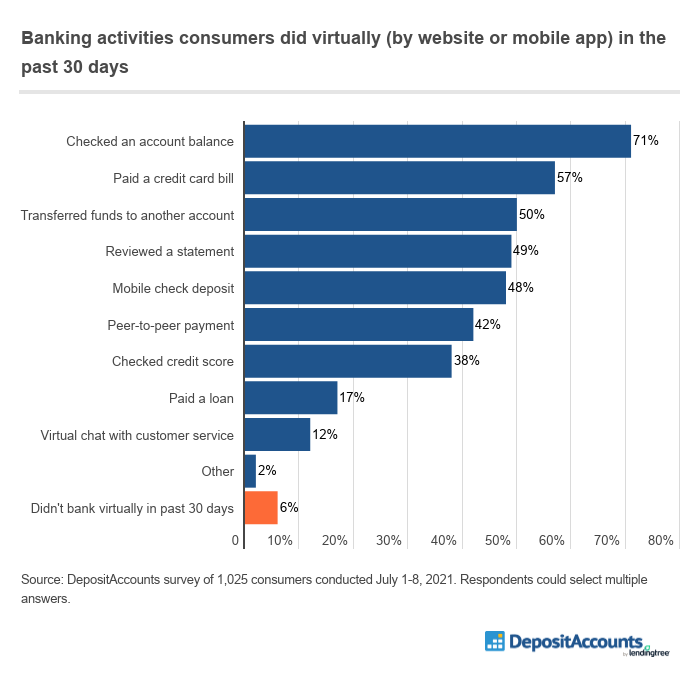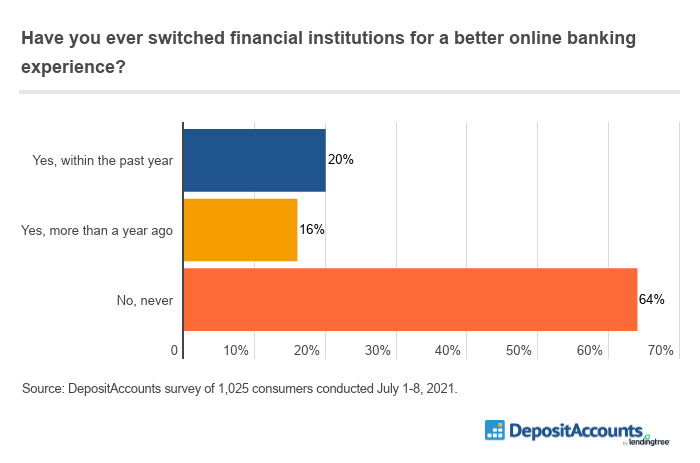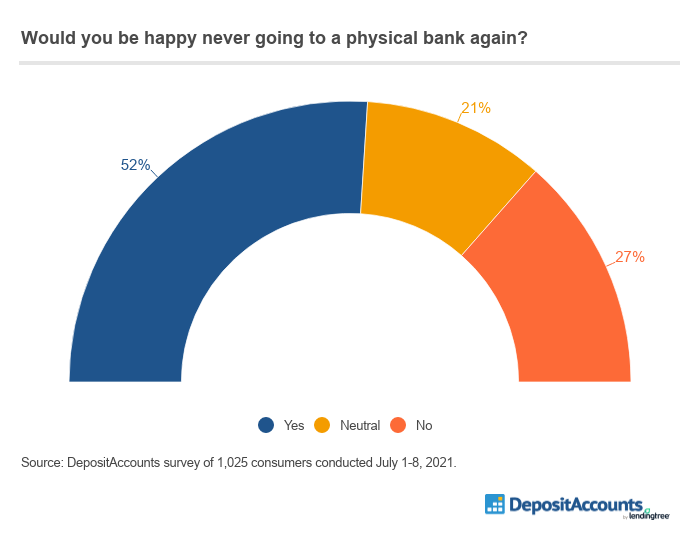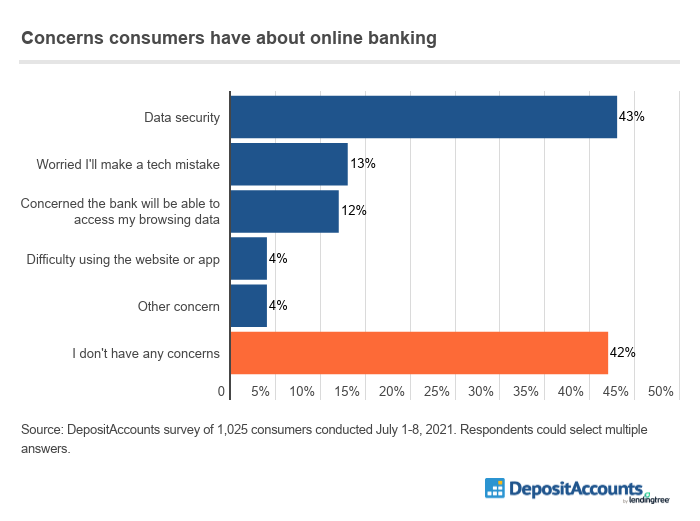The coronavirus pandemic left many anxious about in-person interactions, sparking a surge of online consumer activity from shopping to banking. But that transition presents its own set of challenges; a survey by Deloitte revealed that one major issue with the quick shift to online banking is a lack of ingenuity in the space. Now, many institutions offer a very similar experience that isn’t always straightforward and convenient.
Q2 2021 hedge fund letters, conferences and more
By focusing solely on basic digital banking solutions, banks and their customers working through complex transactions, like investments or mortgages, may suffer. We already know that millennials are far less rigid in their investment strategies than previous generations, and this remains an opportunity for in-person partnership between banks and their customer base. The solution cannot be fully digitalized.
According to a new DepositAccounts survey of more than 1,000 U.S. consumers, 52% of Americans would be happy to never return to a physical branch again, leaving 48% maintaining interest in having some in-person contact with their financial institution. Hybrid banking, meaning in-person and digital offerings, should remain a priority for financial institutions as we turn a new corner in banking.
The below originally appeared on DepositAccounts.com.
Key findings
- Even more consumers are banking virtually, including those 55 and older. 94% of survey respondents have done at least one online or mobile banking activity in the past 30 days, up from 91% last year. The number of baby boomers who bank virtually increased by six percentage points from 81% to 87%.
- 36% of consumers have switched financial institutions for a better online banking experience, including 1 in 5 who did so within the past year. Millennials in particular are most likely to move to a more online-friendly institution (54% have done so), while baby boomers are least likely (14%).
- Most Americans would be happy never going to a physical bank ever again — but baby boomers don’t feel the same. While more than half of respondents in all age groups echo this sentiment, only 31% of baby boomers agree.
- Nearly 45% of consumers are visiting physical banks less often than this time last year. As consumers conduct more banking business online, 42% say the pandemic changed their views of online banking for the better.
- Some consumers are worried about data security, even though 62% of consumers auto-save their passwords for banking apps or websites. Baby boomers are most likely to be worried about security and least likely to auto-save their banking information.
More Americans Are Banking Virtually In 2021
With more Americans using banking websites or mobile apps for their financial needs, the rates with which consumers complete certain tasks are skyrocketing. Some of the most popular tasks include checking account balances, paying credit card balances and transferring funds.
Additionally, some of these categories have seen substantial leaps since DepositAccounts conducted a similar survey last year. The most significant increases are with:
- Paying credit card bills: 26 percentage points (31% to 57%)
- Checking account balances: 25 percentage points (46% to 71%)
- Reviewing bank statements: 18 percentage points (31% to 49%)
- Transferring funds: 16 percentage points (34% to 50%)
Not only are there universal increases in the tools being used by consumers, but many of the increases are significant.
Additionally, 50% of people say they’re using their bank's mobile app or website more often now than this time last year. Just 7% say they’re using it less often. DepositAccounts founder Ken Tumin attributes this to outside influences.
“As more people use features like mobile check deposit and peer-to-peer payments, their friends and family are more likely to follow as they chat and learn from each other,” he says.
More Consumers Are Switching Financial Institutions For A Better Online Experience
As more people transition to completing financial tasks from home, the need for reliable tools is becoming more desirable for many.
“An easy-to-use and feature-rich mobile banking app has become increasingly important for many people,” Tumin says.
This is backed by the survey findings, with 36% saying they have at some point switched financial institutions for a better online banking experience — 20% of which have done so in the past year.
Additionally, consumers say they have an average of three finance-related apps on their phones — the same as in the 2020 survey. This was the case despite 50% saying they’re using the apps more often than this time last year. In fact, 89% check their mobile banking app or website at least once a month.
Further, more than 50% of Gen Zers (ages 18 to 24), millennials (ages 25 to 40) and Gen Xers (ages 41 to 55) say they’re using their bank's mobile app or website more often than this time last year. Only 33% of baby boomers (ages 56 to 75) cite the same, but that’s an increase from 27% last year.
52% Of Americans Never Want To Go Back To Physical Bank Branches
The majority of consumers say they would be happy never going to a physical bank branch for their financial needs ever again.
In addition to those who say they never want to go back to physical branches, 44% say they’ve been visiting physical branches less often now than during the same time last year.
A major reason for this could be that the pandemic has shifted many people’s views of online banking, with 42% saying they feel more positive about online banking. Tumin says the people who still want to go to physical branches may think that a branch visit will at least be occasionally necessary.
Whatever the reason, whether it be adjusting to not having physical branches as an option or the desire to save time, the majority of people now never want to go back to a branch.
The Concerns That Consumers Have About Remote Banking
Despite the usage of online banking through both apps and websites being on the rise, 58% of people have concerns about remote banking. The most prevalent — by far — is data security, with at least 4 in 10 consumers noting it as an area of concern.
Contradicting the data concerns, 62% of respondents say they have their banking password saved on either the app or the website, 22% of which have it saved in both places.
“If someone is able to access your phone or computer, either by stealing or installing malware, they could get access to your passwords,” Tumin warns.
Saving passwords so often makes sense for the increasing percentage of people managing their finances online, so make sure to take the proper precautions to be safe.
Methodology
DepositAccounts commissioned Qualtrics to conduct an online survey of 1,025 U.S. consumers from July 1 to July 8, 2021. The survey was administered using a nonprobability-based sample, and quotas were used to ensure the sample base represented the overall population. All responses were reviewed by researchers for quality control.
We defined generations as the following ages in 2021:
- Generation Z: 18 to 24
- Millennial: 25 to 40
- Generation X: 41 to 55
- Baby boomer: 56 to 75
While the survey also included consumers from the silent generation (defined as those 76 and older), the sample size was too small to include findings related to that group in the generational breakdowns.










